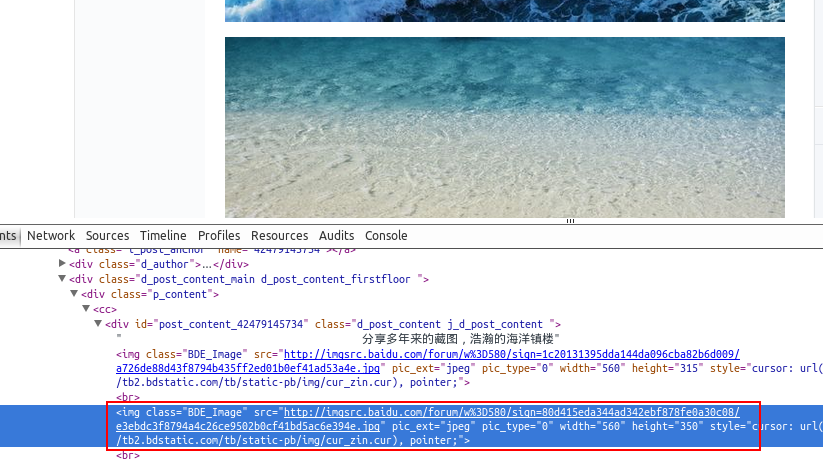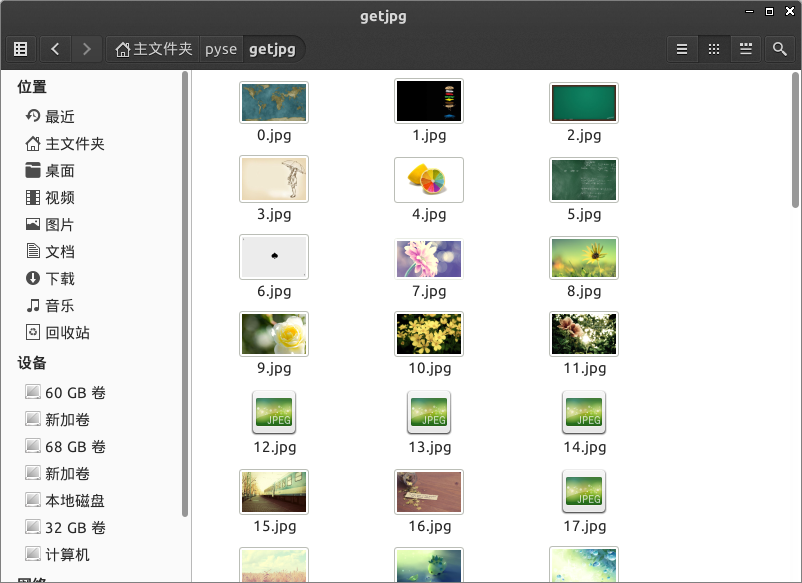python implements simple crawler function
When we browse the Internet every day, we often see some good-looking pictures, and we want to save and download these pictures, or use them as desktop wallpapers, or as design materials.
Our most common method is to right-click the mouse and select Save As. However, some pictures do not have a save as option when you right-click the mouse. Another way is to use a screenshot tool to capture them, but this will reduce the clarity of the picture. Okay~! In fact, you are very good. Right-click to view the page source code.
We can use python to implement such a simple crawler function and crawl the code we want locally. Let's take a look at how to use python to implement such a function.
First, get the entire page data
First we can get the entire page information of the image to be downloaded.
getjpg.py
#coding=utf-8
import urllib
def getHtml(url):
page = urllib.urlopen(url)
html = page.read()
return html
html = getHtml("http://tieba.baidu.com/p/2738151262")
print htmlThe Urllib module provides an interface for reading web page data. We can read data on www and ftp just like local files. First, we define a getHtml() function:
The urllib.urlopen() method is used to open a URL address.
The read() method is used to read the data on the URL, pass a URL to the getHtml() function, and download the entire page. Executing the program will print out the entire web page.
Second, filter the data you want in the page
Python provides very powerful regular expressions. We need to first understand a little knowledge of python regular expressions.
Suppose we find a few beautiful wallpapers in Baidu Tieba and go to the previous section to view the tools. Found the address of the picture, such as: src=”http://imgsrc.baidu.com/forum...jpg” pic_ext=”jpeg”

Modify the code as follows:
import re
import urllib
def getHtml(url):
page = urllib.urlopen(url)
html = page.read()
return html
def getImg(html):
reg = r'src="(.+?\.jpg)" pic_ext'
imgre = re.compile(reg)
imglist = re.findall(imgre,html)
return imglist
html = getHtml("http://tieba.baidu.com/p/2460150866")
print getImg(html)We The getImg() function was also created to filter the required image links in the entire acquired page. The re module mainly contains regular expressions:
re.compile() can compile the regular expression into a regular expression object.
The re.findall() method reads data containing imgre (regular expression) in html .
Running the script will get the URL address of the image contained in the entire page.
Three, save the page filtered data to the local
Traverse the filtered image address through a for loop and save it to the local. The code is as follows:
#coding=utf-8
import urllib
import re
def getHtml(url):
page = urllib.urlopen(url)
html = page.read()
return html
def getImg(html):
reg = r'src="(.+?\.jpg)" pic_ext'
imgre = re.compile(reg)
imglist = re.findall(imgre,html)
x = 0
for imgurl in imglist:
urllib.urlretrieve(imgurl,'%s.jpg' % x)
x+=1
html = getHtml("http://tieba.baidu.com/p/2460150866")
print getImg(html)The core here is the use of urllib.urlretrieve( ) method to directly download remote data to the local.
Traverse the obtained image connections through a for loop. In order to make the file name of the image look more standardized, rename it. The naming rule is to add 1 to the x variable. The save location defaults to the program's storage directory.
After the program is completed, you will see the files downloaded to the local directory in the directory.


Hot AI Tools

Undresser.AI Undress
AI-powered app for creating realistic nude photos

AI Clothes Remover
Online AI tool for removing clothes from photos.

Undress AI Tool
Undress images for free

Clothoff.io
AI clothes remover

Video Face Swap
Swap faces in any video effortlessly with our completely free AI face swap tool!

Hot Article

Hot Tools

Notepad++7.3.1
Easy-to-use and free code editor

SublimeText3 Chinese version
Chinese version, very easy to use

Zend Studio 13.0.1
Powerful PHP integrated development environment

Dreamweaver CS6
Visual web development tools

SublimeText3 Mac version
God-level code editing software (SublimeText3)

Hot Topics
 1670
1670
 14
14
 1428
1428
 52
52
 1329
1329
 25
25
 1276
1276
 29
29
 1256
1256
 24
24
 Python vs. C : Learning Curves and Ease of Use
Apr 19, 2025 am 12:20 AM
Python vs. C : Learning Curves and Ease of Use
Apr 19, 2025 am 12:20 AM
Python is easier to learn and use, while C is more powerful but complex. 1. Python syntax is concise and suitable for beginners. Dynamic typing and automatic memory management make it easy to use, but may cause runtime errors. 2.C provides low-level control and advanced features, suitable for high-performance applications, but has a high learning threshold and requires manual memory and type safety management.
 Python and Time: Making the Most of Your Study Time
Apr 14, 2025 am 12:02 AM
Python and Time: Making the Most of Your Study Time
Apr 14, 2025 am 12:02 AM
To maximize the efficiency of learning Python in a limited time, you can use Python's datetime, time, and schedule modules. 1. The datetime module is used to record and plan learning time. 2. The time module helps to set study and rest time. 3. The schedule module automatically arranges weekly learning tasks.
 Python vs. C : Exploring Performance and Efficiency
Apr 18, 2025 am 12:20 AM
Python vs. C : Exploring Performance and Efficiency
Apr 18, 2025 am 12:20 AM
Python is better than C in development efficiency, but C is higher in execution performance. 1. Python's concise syntax and rich libraries improve development efficiency. 2.C's compilation-type characteristics and hardware control improve execution performance. When making a choice, you need to weigh the development speed and execution efficiency based on project needs.
 Python vs. C : Understanding the Key Differences
Apr 21, 2025 am 12:18 AM
Python vs. C : Understanding the Key Differences
Apr 21, 2025 am 12:18 AM
Python and C each have their own advantages, and the choice should be based on project requirements. 1) Python is suitable for rapid development and data processing due to its concise syntax and dynamic typing. 2)C is suitable for high performance and system programming due to its static typing and manual memory management.
 Learning Python: Is 2 Hours of Daily Study Sufficient?
Apr 18, 2025 am 12:22 AM
Learning Python: Is 2 Hours of Daily Study Sufficient?
Apr 18, 2025 am 12:22 AM
Is it enough to learn Python for two hours a day? It depends on your goals and learning methods. 1) Develop a clear learning plan, 2) Select appropriate learning resources and methods, 3) Practice and review and consolidate hands-on practice and review and consolidate, and you can gradually master the basic knowledge and advanced functions of Python during this period.
 Which is part of the Python standard library: lists or arrays?
Apr 27, 2025 am 12:03 AM
Which is part of the Python standard library: lists or arrays?
Apr 27, 2025 am 12:03 AM
Pythonlistsarepartofthestandardlibrary,whilearraysarenot.Listsarebuilt-in,versatile,andusedforstoringcollections,whereasarraysareprovidedbythearraymoduleandlesscommonlyusedduetolimitedfunctionality.
 Python: Automation, Scripting, and Task Management
Apr 16, 2025 am 12:14 AM
Python: Automation, Scripting, and Task Management
Apr 16, 2025 am 12:14 AM
Python excels in automation, scripting, and task management. 1) Automation: File backup is realized through standard libraries such as os and shutil. 2) Script writing: Use the psutil library to monitor system resources. 3) Task management: Use the schedule library to schedule tasks. Python's ease of use and rich library support makes it the preferred tool in these areas.
 Python for Web Development: Key Applications
Apr 18, 2025 am 12:20 AM
Python for Web Development: Key Applications
Apr 18, 2025 am 12:20 AM
Key applications of Python in web development include the use of Django and Flask frameworks, API development, data analysis and visualization, machine learning and AI, and performance optimization. 1. Django and Flask framework: Django is suitable for rapid development of complex applications, and Flask is suitable for small or highly customized projects. 2. API development: Use Flask or DjangoRESTFramework to build RESTfulAPI. 3. Data analysis and visualization: Use Python to process data and display it through the web interface. 4. Machine Learning and AI: Python is used to build intelligent web applications. 5. Performance optimization: optimized through asynchronous programming, caching and code




